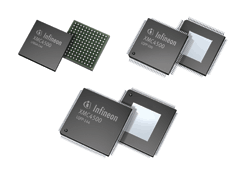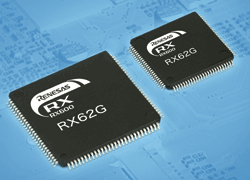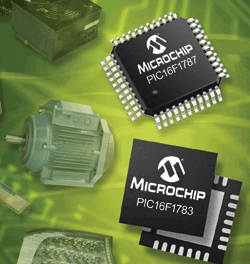You just can’t have “industrial” without motors and they need controller chips. Let’s look at five recent additions to this important area.
Infineon’s 120-MHz XMC4000 MCU family (www.infineon.com) targets energy-efficient real-time industrial control with an ARM Cortex M4 core and flexible peripherals built around a Connection Matrix. The matrix uses multiplexers on the I/O signals of each peripheral to allow each module or slice of a module to trigger events in other components independently of the core CPU or bus system.

After initialization, the chips’ peripherals operate with no intervention by the core CPU. They are repetitive in two ways: with multiple instances of a peripheral type and subdivision into multiple identical slices. Each chip has 1 Mbyte of eFlash including hardware ECC, 160 Kbytes of RAM, 12-channel DMA, and IEEE 1588 compliant Ethernet MAC, three CAN nodes, 12-bit A/D converter kernels with up to 26 channels, and USB 2.0 full-speed on-the-go. Extended temperature range up to 125°C is available, and samples can be ordered now.
Texas Instruments (www.ti.com) offers the DK-LM3S-DRV8312 motor control kit to showcase its three-phase brushless dc motor driver and demonstrate the operational advantages of TI’s InstaSPIN BLDC control solution’s simplified tuning, immediate acceleration, and reliable low-speed operation. The brains of the kit is a low-cost Stellaris LM3S818 MCU on a controlCARD module that is pre-programmed with all the necessary firmware in flash memory. Also included are the Crosshairs embedded kernel and the PC application interface that enables the control and monitoring of the entire system.
The kit has a DRV8312 DMC baseboard with a slot for the controlCARD, a 55-W NEMA17 brushless dc motor, a 24-V 2.5-A dc power adapter, cables/accessories, complete documentation, source-code and binaries for the controlCARD, and Code Composer Studio IDE.

Features of the kit’s DRV8312 motor control board include a three-phase inverter power stage capable of PMSM or BLDC motor control, isolated JTAG on the controlCARD, a quadrature encoder interface, and a Hall sensor input. The kit is just $299. See www.ti.com/tool/dk-lm3s-drv8312.
The International Rectifier (www.irf.com) IRS2334SPbF and IRS2334MPbF are three-phase 600-V gate driver ICs for inverter motor drive applications. They come in SOIC20WB or QFN5X5 packages and can use 3.3-V inputs.
The three-phase IC family provides protection for both negative-voltage spikes and short-circuit events. The ICs’ output drivers feature a high-pulse-current buffer stage with minimum driver cross-conduction. Propagation delays are matched to simplify use at high frequencies, and floating channel can be used to drive n-channel power MOSFET or IGBTs in the high-side configuration. The ICs feature protection for undervoltage lockout, dead-time, and shoot-through. They cost $1.95 each in lots of 10,000 and are available now.
The Renesas (http://am.renesas.com) 32-bit RX62G microcontroller is optimized for digital power control applications including motor control with PFC for digital power supply, UPS, and solar inverters. It has 128 or 256 Kbytes of no-wait-state flash, plus an additional 32 Kbytes of flash and 8 or 16 Kbytes of fast SRAM.

The 100-MHz/165-DMIPS IC has a single-precision 32-bit IEEE-754 floating-point accumulator, a multiply/divide unit, fast interrupts, and a five-stage pipeline. It has two 12-bit and one 10-bit A/D converter, four 312.5-ps high-resolution timers, and a 16-bit general-purpose PWM timer. The MCU can control up to three three-phase motors simultaneously and CAN channels are optional. The ICs cost $3.95 each in lots of 10,000, and production will commence in mid-2012.
The low-cost PIC16F1787 8-bit microcontroller from Microchip (www.microchip.com) can handle some tough motor control apps with three 16-bit programmable switch-mode controller modules that use digital and/or analog feedback for frequency control and have 16-ns clock resolution, advanced dead-band control, and auto-shutdown and restart.

The MCU also has a 12-bit A/D converter with seven differential or fourteen single-ended inputs, four fast comparators with selectable voltage references and 50-ns response time, three operational amps, and an 8-bit D/A. It has 14 Kbytes of flash program memory and 1 Kbyte of SRAM, and features supply currents as low as 150 µA from a 1.8-V supply at 1 MHz and 50 nA in standby mode. The chip has a wide operating voltage range of 2.3 to 5.5 V for the “F” version and 1.8 to 3.6 V for the low-power “LF” variant. Versions in this MCU family come in packages as small as 4 x 4 mm (UQFN) and start at just $1.18 each per 10,000.
Jim Harrison
Advertisement
Learn more about Electronic Products Magazine





